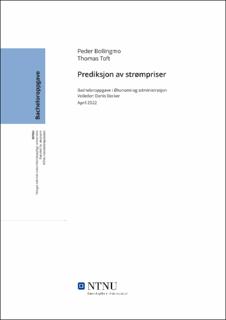| dc.contributor.advisor | Becker, Denis | |
| dc.contributor.author | Bollingmo, Peder | |
| dc.contributor.author | Toft, Thomas | |
| dc.date.accessioned | 2022-06-11T17:19:42Z | |
| dc.date.available | 2022-06-11T17:19:42Z | |
| dc.date.issued | 2022 | |
| dc.identifier | no.ntnu:inspera:108384214:110282881 | |
| dc.identifier.uri | https://hdl.handle.net/11250/2998401 | |
| dc.description.abstract | De økende kraftprisene har fått mye oppmerksomhet den siste tiden, og mange har utrykt sin misnøye og uro knyttet til de høye strømprisene. Å kunne finne modeller som predikerer prisene vil kunne gi en økt grad av kontroll, og være med på å gjøre kraftmarkedet mer forutsigbart. Det er mange veier man kan gå for å utvikle gode forklaringer på bevegelsene i kraftmarkedet, men vi har valgt å se på to ganske ulike modeller for å kunne jobbe mot å finne en trend, som kanskje kan bidra til videre forskning.
Problemstillingen vi landet på er «Kan et kunstig nevralt nettverk predikere historiske elspot priser bedre enn en linære modell?». Problemstillingen spesifiserer at det handler om forskjellen på de to modellene, selv om det selvsagt også er interessant å se på resultatene isolert sett. Ved bruk av denne problemstillingen valgte vi ut data basert på teori om kraftmarkedet og dens drivere. Her har vi både med de relativt åpenbare direkte faktorene slik som: produksjon, forbruk, temperatur, vindstyrke og mengden vann i vannmagasiner. I tillegg til at vi har med en mengde mindre åpenbare og indirekte faktorer slik som: valutakurs, kullpris, karbonutslippskvoter og prisen på naturgass. Etter å ha skalert disse variablene til sammenlignbare størrelser har vi lagt de inn i våre to modeller. Antagelsen og målet var at det kunstige nevrale nettverket skulle klare å finne sammenhenger som den linære modellen ikke finner, og med det kunne skape bedre og mer presise prediksjoner.
Konklusjonen ble litt annerledes enn forventet, og vi ser at LSTM modellen predikerer bedre enn regresjonsmodellen på treningsdataene. Vi ser derimot at resultatene er litt mer uklare når det kommer til testdataene. MSE og MAPE favoriserer forskjellige modeller, og ved visuell inspeksjon ser vi at ingen av modellene kan predikere spesielt godt. Dette tyder på at begge modellene predikerer dårlig på virkelig data | |
| dc.description.abstract | The rising power prices have received a lot of attention recently, and many have expressed their dissatisfaction and unrest related to the high electricity prices. Being able to find models that predict prices will provide an increased degree of control and help to make the power market more predictable. There are many ways one can go to develop good explanations for the movements in the power market, but we have chosen to look at two quite different models to work towards finding a trend, which may contribute to further research.
The issue we landed on is " Can an artificial neural network predict historical electricity spot prices better than a linear model? ". The problem specifies that it is about the difference between the two models, although of course it is also interesting to look at the results in isolation. Using this problem, we selected data based on theory about the power market and its drivers. Here we have both the relatively obvious direct factors such as: production, consumption, temperature, wind power and the amount of water in the water reservoirs. In addition to that we have several slightly less obvious and indirect factors such as: exchange rate, coal price, carbon emission quotas and the price of natural gas. After scaling these variables to comparable sizes, we have included them in our two models. The assumption and goal were that the artificial neural network should be able to find connections that the linear model does not find, and with that could create better and more precise predictions.
The conclusion was slightly different than expected, and we see that the LSTM model predict better than the regression model on the training data. On the other hand, we see that the results are a little more unclear when it comes to the test data. MSE and MAPE favor different models, and on visual inspection we see that none of the models can predict particularly well. This suggests that both models predict poorly on real data. | |
| dc.language | nob | |
| dc.publisher | NTNU | |
| dc.title | Prediksjon av strømpriser | |
| dc.type | Bachelor thesis | |
